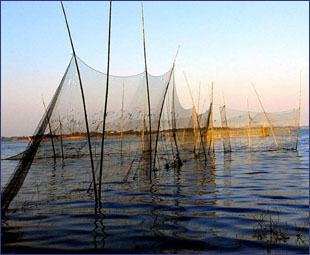Poyang Lake in Jiangxi Province, China's largest freshwater
lake, has suffered from alarmingly low water levels since 2006.
Some irresponsible people have erected small dams around the lake,
occupying public waters for their personal use. Labeled "draining
the pond to get all the fish," these illicit actions have not only
severely damaged the local ecology but also harmed fishing
production. Deputies to the Fifth Session of the Tenth National People's
Congress (NPC), which concluded yesterday in Beijing,
have united in calling for helping fishery resources recover by
stimulating ecological improvement and cracking down on
lawbreakers.
 |
To date, Poyang and Yugan county governments have destroyed a
dozen illegal dams to help alleviate the pressure on local fishing
resources. Moreover, deputies to the 10th National People's
Congress have called for an end to a traditional way of living near
Poyang, known as "living near the water, living off the water."
They argue that local people living in this manner are making
illegal use of local resources.
Poyang Lake benefits not only Jiangxi Province, but is also
essential to the whole Yangtze River Delta, said Fu Qionghua, chief
engineer with the Jiangxi Water Conservancy Research Institute and
an NPC deputy, adding "that its health will also ensure the
well-being of the water supply to Jiangsu and Shandong provinces and Tianjin Municipality. It thus stands out as a
national strategic storage of water resources."
The Poyang Lake lies in the north of Jiangxi Province and
on the southern bank of the Yangtze River. It extends for 162,200
square kilometers, covering close to 9 percent of total Yangtze
River valley. Its basin is also a fertile ground, serving as one of
China's important grain production bases.
Fu said that the illegal dams are also interfering with the
natural flow of floodwater. Poyang Lake has five tributaries in the
province, the Ganjiang, Fuhe, Xinjiang, Raohe and Xiushui rivers,
which all contribute to the lake's water levels. "The dams reduce
the water surface area and water capacity. Once the flood season
comes, the lake's flood control function will greatly be weakened,"
said Fu.
Xu Suhui, director of the Jiangsu Provincial Environmental
Protection Bureau, revealed a lack of cooperation between local
authorities, particularly the fishery, forestry and water
conservancy departments. "They lack coordination and cooperation,
so law enforcement systems must be reformed," she stressed.
Prior to the 1980s, moves to reclaim land from the lake and
artificially receding the waters further worsened by rapid
population growth, which led to frequent floods and prolonged
periods of drought.
Since 1998 when the Yangtze River was ravaged by massive floods,
the Chinese government has launched a range of programs aiming to
"let cultivated land revert to its natural state." Thanks to this,
Poyang Lake's surface has increased from 3,950 square kilometers in
1998 to 4,350 square kilometers today, with over 900,000 residents
moving away from the lake area.
Director Fu explained that the encroachment on water areas is
directly related to the area's industrial landscape. "To change the
situation, local governments adopt an ecological recovery system
which will complement the area's economic development," Fu
said.
Addressing the need to curb the illegal use of wetlands and
fishing resources around the lake, Ni Guoxi and Chen Qinghua, two
members of the Chinese People's Political Consultative Conference
(CPPCC), submitted a joint proposal to the fifth
session of the 10th CPPCC National Committee, calling
for precise legislation addressing the implementation of the Poyang
Lake ecological protection project. Their plan proposed that the
Chinese government place the project under a specialized plan
benefiting from tailored investment to rapidly make the lake "a
wetland with a good ecology and environment."
(China.org.cn by Li Jingrong March 17, 2007)